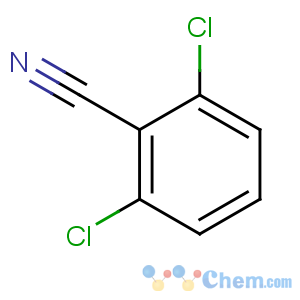Title: Dichlobenil
CAS Registry Number: 1194-65-6
CAS Name: 2,6-Dichlorobenzonitrile
Manufacturers' Codes: H-133; Niagara 5006
Trademarks: Casoron (Solvay Duphar)
Molecular Formula: C7H3Cl2N
Molecular Weight: 172.01
Percent Composition: C 48.88%, H 1.76%, Cl 41.22%, N 8.14%
Literature References: Prepn: Reich,
Bull. Soc. Chim. Fr. [4]
21, 217 (1917); Norris, Klemka,
J. Am. Chem. Soc. 62, 1432 (1940); Chang
et al., C.A. 53, 6134d (1959); Koopman,
Rec. Trav. Chim. 80, 1075 (1961); Hackmann, ten Haken
GB 861899; Higson,
GB 862937 (both 1961 to Shell). Use as herbicide: Koopman, Daams,
US 3027248 (1962 to N. A. Phillips). Fate in crops, soil and animals: Beynon, Wright,
Residue Rev. 43, 23 (1972); Veroop,
ibid. 55. Toxicity data: G. W. Bailey, J. L. White,
ibid. 10, 97 (1965).
Properties: Crystals from petr ether, mp 144-145°. Soly in water at 25°: 25 ppm; at 20°: 18 ppm. Vapor pressure at 20°: 3 ′ 10-6 mm Hg; at 25°: 5 ′ 10-4 mm. Absorption spectrum see Koopman,
loc. cit. LD50 in rats, mice (mg/kg): 2710, 6800 orally (Bailey, White).
Melting point: mp 144-145°
Toxicity data: LD50 in rats, mice (mg/kg): 2710, 6800 orally (Bailey, White)
Use: Herbicide.

